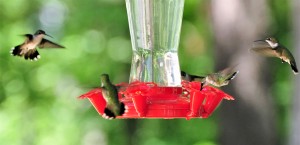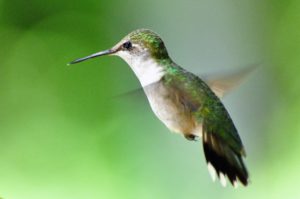Photography courtesy of Lowell Washburn, all rights reserved.
Mix the sugar water; lock and load the feeders. The fall migration of ruby-throated hummingbirds has arrived in North Iowa. For anyone wishing to view good numbers of these tiny travelers; there’s no better time than now.
Keeping an eye on backyard nectar feeders is one of the easiest and best ways to get a close up look at Iowa’s smallest migratory bird. Commercial nectar mixes are great hummingbird attractants. You can produce your own, equally appealing food, by going to your kitchen cupboard. Mix one-part white sugar to four parts water. Stir in sugar, bring to a boil [kills bacteria], cool to room temp, and add to feeder.
If brushy habitats, flower gardens, or mature woodlands are in the vicinity, then you probably already have migrating hummingbirds nearby. After installing new feeders, the first hungry visitors should appear within hours, sometimes within minutes. Adult hummingbirds zealously protect food sources and when it comes to feeders, they generally do not play well with others. A partial solution, and a good way to attract and observe more birds, is to place multiple feeders on both sides of your home.
Although some of the hummingbirds we’re seeing are homegrown, most are currently arriving from points north – some from as far away as Ontario and northern Minnesota. Although hummingbird numbers will peak during the first half of September, the migration will continue with reduced intensity until withering frosts drive the last stragglers southward. Most ruby-throats will spend the winter months in Central America. Getting there is no small feat. Guided by starry constellations and with wings churning in excess of 50 beats per second, they will leave the Texas mainland and head directly across the Gulf of Mexico. Exhausting fuel reserves and taking physical endurance to the limit; the birds will cross the entire watery expanse in a single nighttime flight. It’s an incredible achievement for a bird weighing less than a quarter of an ounce and with a wingspan of just four inches.




 Tom Cope
Tom Cope Sue Wilkinson
Sue Wilkinson Susan Judkins Josten
Susan Judkins Josten Rudi Roeslein
Rudi Roeslein Elyssa McFarland
Elyssa McFarland Mark Langgin
Mark Langgin Adam Janke
Adam Janke Joe Henry
Joe Henry Kristin Ashenbrenner
Kristin Ashenbrenner Joe Wilkinson
Joe Wilkinson Dr. Tammy Mildenstein
Dr. Tammy Mildenstein Sean McMahon
Sean McMahon